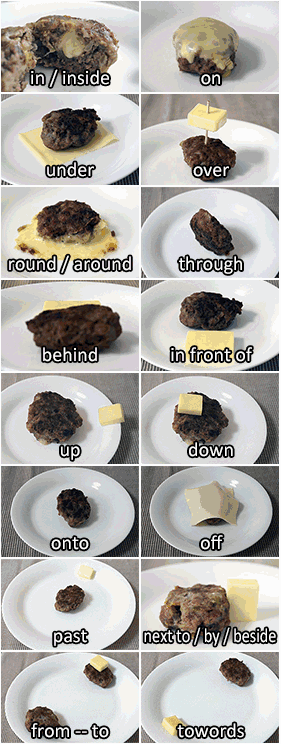| 一篇文章教会你介词用法辨析!时间 方位 地点 易混淆介词都有 | 您所在的位置:网站首页 › across的介词用法总结 › 一篇文章教会你介词用法辨析!时间 方位 地点 易混淆介词都有 |
一篇文章教会你介词用法辨析!时间 方位 地点 易混淆介词都有
|
B.介词by表示“到…时为止,不迟于…”如:The work must be finished by Friday. 6. 时间介词till与until用法的异同 A.till和until用在肯定句中,均可表示“直到…为止”,如:I will wait till(until)seven o'clock. B.till和until用在否定句中,均可表示“在…以前”或“直到…才”。 如:Tom didn't come back till(until)midnight. C.till多用于普通文体,而until则用于多种文体,并且在句子开头时,用until而不用till。 如:Until he comes back,nothing can be done. 7. 不用介词表达时间的几种情况 A.当表示时间的词前有this, that时,其前面不用介词,如:this morning B.当表示时间的词前有next时,其前面不用介词,如:next Sunday C.当表示时间的词前有last时,其前面不用介词,如:last Sunday D.当表示时间的词前有one, any, each, every, some或all时,其前面不用介词,如:You can come any day. 方位介词与地点介词的用法辨析 1. 方位介词on, over, above的用法辨析 A.介词on表示一物放在另一物上面,两者紧贴在一起,如:The book is on the table. B.介词over表示一种垂直悬空的上下关系,即“在…上方”,如:Is there any bridge over the river? C.介词above表示一般的“高于…”,“在…之上”,如:There was an electric clock above his bed. 2. 方位介词under与below的用法辨析 A.介词under是over的反义词即“在…下方”,如:They were seen under the tree. B.介词below是above的反义词即“低于…”,“在…之下”,如:They live below us. 3. 方位介词across,、through、over,、past的用法辨析 A.介词across着重于“从一头或一边到另一头或另一边”,强调从表面穿过。 如:She went across the street to make some purchases. B.介词through着重于“穿越”,强调从一定的空间内穿过。 如:The sunlight was coming in through the window. C.介词over多表示从“上方越过”,如:He failed to go over the mountain; he had to go round it. D.介词past表示从“面前经过”,如:Someone has just gone past the window. 4. 方位介词in、on、at的用法辨析 A.介词in表示“排、行、组”,如:We are in Team One. B.介词on表示“左、右”,如:Li Ping is on my left. C.介词at表示“前、后”,如:I sit at the front of the classroom. 5. 方位介词to、for的用法辨析 A.介词to表示目的地或去的目的,如:Will you take a train to Tianjin. B.介词for表示动身去某地,如:He got on a train for Shanghai. 6. 地点介词at与in的用法辨析 A.介词at表示较小的地方,如家、村、乡村等,如:He lives at a small village. B.介词in表示较大的地方,如大城市、国家、洲等,如:He lives in Beijing. 7. 地点介词at与on的用法辨析 A.介词at用于门牌号,如:He lives at No.200, Nanjing Road. B.介词on用于路名,如:He lives on Nanjing Road. 8. 地点介词in、on、to的用法辨析 A.介词in表示“包含”如:Beijing is in the north of China. B.介词on表示“紧邻”如:Canada lies on the north of the U.S. C.介词to表示“没接触”如:France lies to the south of England. 其他易混介词的用法辨析 1. 动作介词to与toward的用法辨析 A.介词to表示向某处移动,如:They were driving to work together. B.介词toward 表示移向某处,如:We're moving toward the light. 2. 原因介词because、as、for的用法辨析 A.介词because表示“因为;由于”指直接的、明确的原因,回答why的问句,语气最强。 如:The boy was absent because he was ill. B.介词as表示“由于;鉴于”指一种显而易见、谈话双方已知的理由。 如:She stayed at home as she had no car. C.介词for表示“因为;由于”指一种间接原因,甚至只是一种附带的说明。 如:It must have rained last night, for the road is wet. 3. 材料介词of和from的用法 A.介词of用于成品与材料的性质不变时,如:The desk is made of wood. B.介词from用于成品与材料的性质已变时,如:Wine is made from grapes. 4. 表示“用”的介词in、with、by的用法辨析 A.介词in表示“用材料、语言”如:Can you say it in English? B.介词with表示“用工具、某物”如:with a pen C.介词by表示“用、以、靠、通过…方法”如:He prefers traveling by car. 5. 介词between与among的用法辨析 A.介词between 表示“在两者之间”如:Don’t sit between the two girls. B.介词among表示“在…当中(三者或以上)”如:They lived among the mountains in the past. 6. 介词besides与except的用法辨析 A.介词besides表示“除…之外(全部计算在内)”如:We have seen the crocodile besides Li Fang. B.介词except表示“除…之外(不计算在内)”如:We are all Chinese except Tomin our class. 经常有人被表方位的英语介词搞晕,不知道到底在什么位置用哪个词。 今天就用几张图告诉你们~一目了然!
转自网络 版权归作者所有 主页君诚意推荐 99%的留学大婊贝都用过下面这个……点击左下“阅读原文”试试 回复“作文”,最细致的雅思作文批改 回复“社群”,加入内部交流微信群返回搜狐,查看更多 |
【本文地址】
| 今日新闻 |
| 推荐新闻 |
| 专题文章 |

